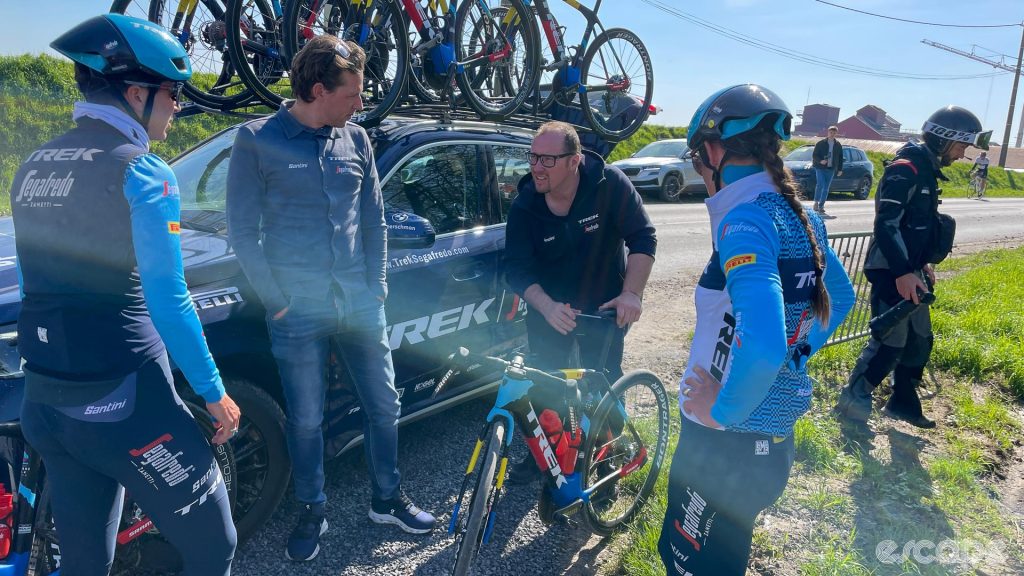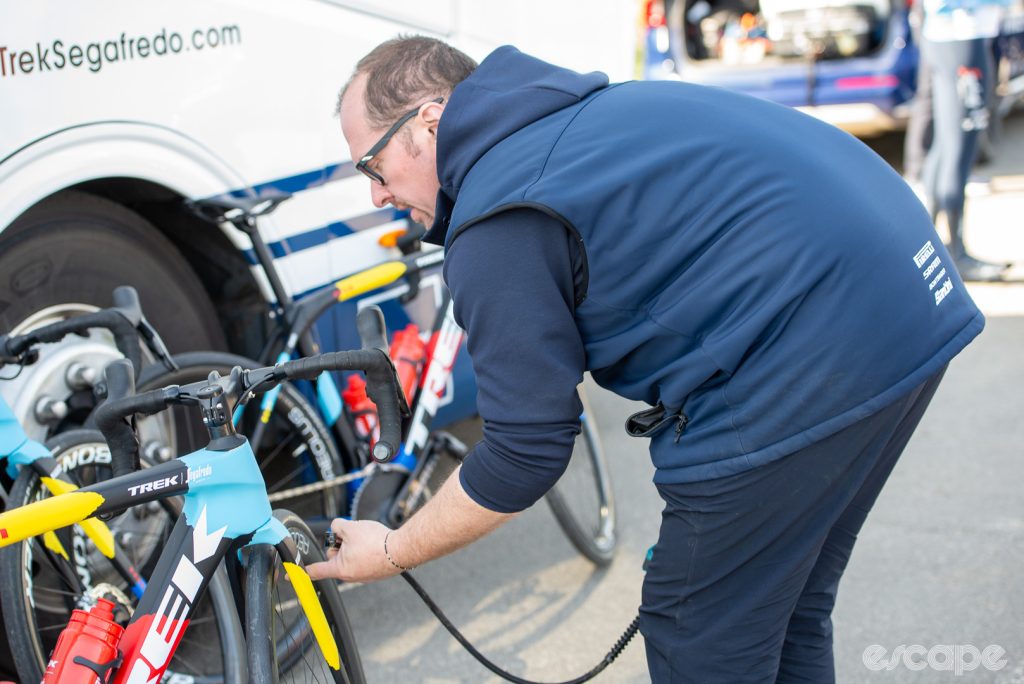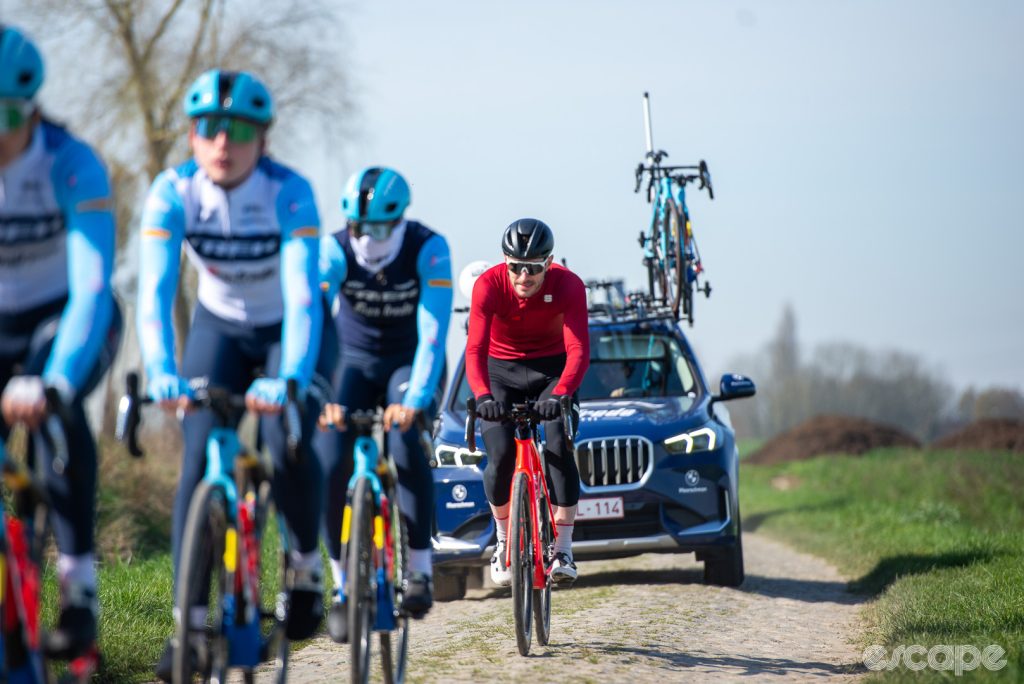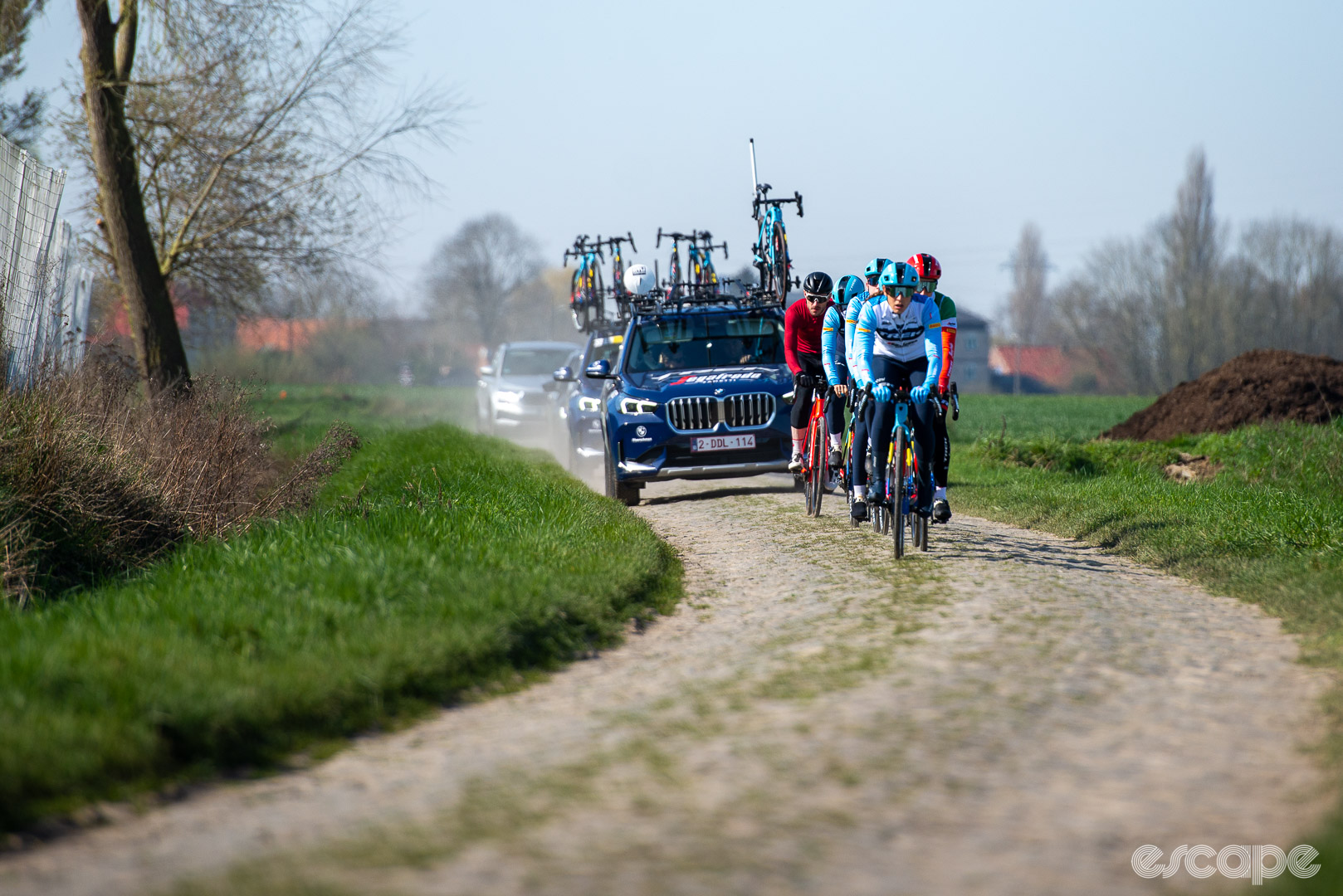What happens on a Roubaix recon ride? I’ve asked that question every year since I first heard of the annual pre-Hell of the North ritual. My tech head assumed teams spent the day testing tyre pressures, wheels, and all manner of quasi-suspension, but how can the teams dedicate such time and effort to testing only days out from one of the biggest races of the year?
We joined Trek-Segafredo squad, a group undefeated at Paris-Roubaix Femmes avec Zwift, on their recon ride to find out. The answer was a little anti-climactic but fascinating all the same.
What happens on the recon ride?
On the one hand, the answer is simple, a recon ride is, as the name suggests, a reconnaissance mission.
Reconnaissance – observing the lay of the land and ascertaining strategic features.
Dictionary
On the other hand, I’ve always wondered what strategic features teams can ascertain and how relevant the lay of the recon day land is with just a few teammates for company and all the time in the world. That land will look entirely different come race day and surrounded by 100 or more competitors.
It’s a fact not lost on Lucinda Brand, who stood on the Roubaix podium in 2022, her first participation in the Hell of the North. Having eschewed the inaugural race in 2021 in preparation for the cyclo-cross season, Brand headed into the 2022 race in the unfamiliar position of the least experienced rider in the peloton. She sees the value in scouting the course, but when asked if the recon ride last year gave her extra confidence heading into her first Roubaix, she wasn’t so sure. “The race dictates,” she said, trailing off.

The race dictates, but Brand does value every additional chance to ride the pavé. The men’s peloton has raced these roads for over a hundred years, passing that experience through the generations. Even a rookie in the men’s Paris-Roubaix peloton will have access to the combined expertise garnered by their teammates and team staff’s past participations. As Brand explains, the guys have ridden these roads so many times they develop a sense of where the holes, ridges, and worst cobbles will be. It’s a sense and a feeling that only riding the paving / doing the thing will develop.
Roubaix is so chaotic, the bunch so stressed, and the pavé so bad, that learning the ridges and holes might seem an impossible task. But equally, knowing and avoiding just one “murder rock” could save your race. Again, the best way to learn this thing is to do this thing. Brand can’t point to anything specific they might garner from the recon ride, but sees it as another lodgement in the experience bank.
Familiarisation
Perhaps “recon ride” is not the best descriptor. Many of the team refer in some manner to refamiliarising the mind and body with the cobbles and Roubaix-specific bikes. Riding on cobbles requires a very different style to any other road riding. The best riders glide over the pavé in bigger gears, hands on the tops, and weight pushed back. It’s a riding style that is easy to describe but difficult to implement effectively. The Trek squad started their recon in Orchies and were on the pavé within a few hundred metres, wasting no time.
They (the cobbles) are all shitty. Even if you see a hole in recon, you forget in the race. You just always have to be ready.
Ina Teutenberg
I had pictured riders repeating sectors multiple times, scouting lines, adjusting tyre pressure, and getting a feel for the cobbles at race intensity. At least based on to Trek’s ride, I was almost entirely wrong. There was no doubling back, no race-paced efforts, and only Elisa Longo Borghini made tyre pressure adjustments. She asked for 33 and 35, which could mean 3.3 and 3.5 bar (47-50psi) or 33 and 35 psi. Given the big tyres and Longo Borghini’s size, our educated guess is the latter.
Both Elynor Bäckstedt and Trek-Segafredo’s director Ina Teutenberg explained the riders simply need a long training ride today, so it might as well be on the route. As for intervals or efforts, Bäckstedt summed it up pretty effectively, “the cobbles are efforts enough.”
Bäckstedt is the team’s Roubaix rookie this year, but has a fair share of Roubaix heritage in both her family and team. The recon ride provided an opportunity to trial the advice her Roubaix-winning father and teammates had passed on, but again Elynor was cognisant that course knowledge only counts for so much, and ultimately, having the legs is key.
Even as a director, there isn’t a lot Teutenberg can garner from recon day. She spent most of the day in the following car, making notes on the Veloviewer app, before hopping out and riding the final 10-20 km with the team. “We will have a strategy, but Roubaix is one of these races you have to adjust on the go. You will have bad luck but can always come back … The race always dictates.”
It’s just nice to get here early, relax, and avoid any stress.
Ina Teutenberg on the value of recon day.
Testing, Testing, 1,2
The Trek-Segafredo team have placed first and third in both editions of Paris-Roubaix to date. Four of the available six podium spots, in other words. That’s why I wanted to follow this team on recon. I was intrigued to see what tech testing they did on recon that might be giving their world-class riders an edge.
The answer was almost nothing. The multiple runs testing tyre pressure and different setups didn’t happen. As Koen de Kort, team support manager at Trek-Segafredo explained, the team has the basis of a winning formula from the past two years.
The recon was just a final test for already-dialled Roubaix setups. Any interventions now are minor tweaks to this formula and trialled months in advance. The team spent plenty of testing days in and around Roubaix in 2021, 2022, and as recently as February of this year. Recon day is merely a familiarisation ride.

Ilaria Sanguineti will line up for her third Roubaix on Saturday morning. She is as experienced as is possible in Paris-Roubaix Femmes, but immediately explained how valuable the recon ride is in familiarising herself with the Roubaix bike. 2023 is her first year with Trek, and as such, this week is her first ride on the new Domane.
In speaking with Sanguineti, it’s immediately obvious how in tune she is with the ride feel of each bike. She speaks of switching from Emonda to Madone, and the value of recon day in familiarising herself with the Domane on pavé. Most of the team said they felt at home on the Domane almost immediately because the mechanics can replicate their riding position so closely and they have ridden the bike previously. But for Sanguineti it was a first ride on the new bike and she explained the wider and softer tyres meant the bike responds differently. Resetting the body’s perception of normal before race day is vital.
“With new bikes, you should always test if everything is working, and there’s no better test if everything is tight than riding the cobbles.”
De Kort
I was keen to dig into testing done over the past years. What did the team test? How do the team ensure repeatability and accuracy when doing repeats across cobbles? What’s the wildest tech intervention they have tested?
Understandably they were quite tight-lipped about it all. De Kort explained the team had already used the new Domane last year, and the riders had already converted from tubular to tubeless, all that’s left to test is individual tyre pressures and gearing each rider prefers.
The team has found their preferred recipe. We can see the ingredients in the bikes they race, but determining the make-up of the secret sauce is still a closely guarded secret.
I hoped the SRAM support crew on hand for the recon might shed more light on this process. However, as SRAM race technician Sam Watts explained their day went perfectly as they had nothing to do.
The brand attended the team testing days over the past months and years, but their role is to ensure the equipment required for testing is on hand rather than suggesting what to test. “Recon day is too late to make any changes,” Watts said. “Trek has won the past two additions, and their preparation in September, December, and February is incredible. The work is done before today.”

Pushing SRAM for more details on what exactly the team tested in advance doesn’t exactly elicit any tech nuggets. Gearing and tyre pressures are the two biggest things we can adjust at Roubaix, SRAM’s reps told us. SRAM leaves the exact setups up to the performance team at Trek, and focuses on providing the technical support to enable whatever tech interventions the team has planned.
The team aren’t exactly resting on their laurels either, though. There is that new Domane and, while the 1x drivetrains are retained, the entire squad is now on 52-tooth chainrings rather than the 50-tooth 1x chainring Lizzie Deignan used on her way to victory in 2021. That increase in chainring size is attributed to all the testing the team has done since that first win.
We do recons with our teams in December to ensure everything is dialed months in advance.
Sam Watts – SRAM Race Technician
Long story short, recon day is effectively a hyper-supported training ride for the pros. In hindsight, that isn’t at all surprising. A pro team, with a 100% record in one of the biggest races of the season, has its plan dialled months in advance. That’s just being professional.
As Lucinda Brand said as we reached the Roubaix Velodrome, “What did I learn today? Well, the cobbles are still shit.”
One more rookie

The ride was also my first proper Roubaix experience. Having watched Roubaix for the better part of two decades, and despite racing all across Belgium, I was more than a little nervous rolling out with a group of pros for my first proper outing on the cobbles.
In chatting with the riders, I quickly realised the team wasn’t intending to garner much from the ride, certainly, the testing had all finished months ago.
For me, though, a Roubaix rookie, I thought the ride was invaluable. The cobbles are violent, and the race will be at another level. But if I was lining up as a rookie at the weekend, the recon told me I can ride the cobbles. They are rough, but they are manageable.
I rode with 32 mm tyres and a slow puncture, so I tested every pressure from 55 psi right down to 30 psi. I learned I like my tyres around 50 psi.
The replacement wheel I eventually got had a 30 mm tyre. I learned I prefer a 32 mm tyre.
I learned I preferred to corner in the drops on the pavé, but I was most comfortable riding on the tops on the straights. That said, I didn’t like reaching from the tops to the shifters on the pavé. A mid-recon tech intervention to add wireless blips meant I could shift from the tops and made for easier mid-sector shifting.
All told I found the recon massively valuable, the pro team found it less so, but I guess that’s hardly surprising.
What did you think of this story?

